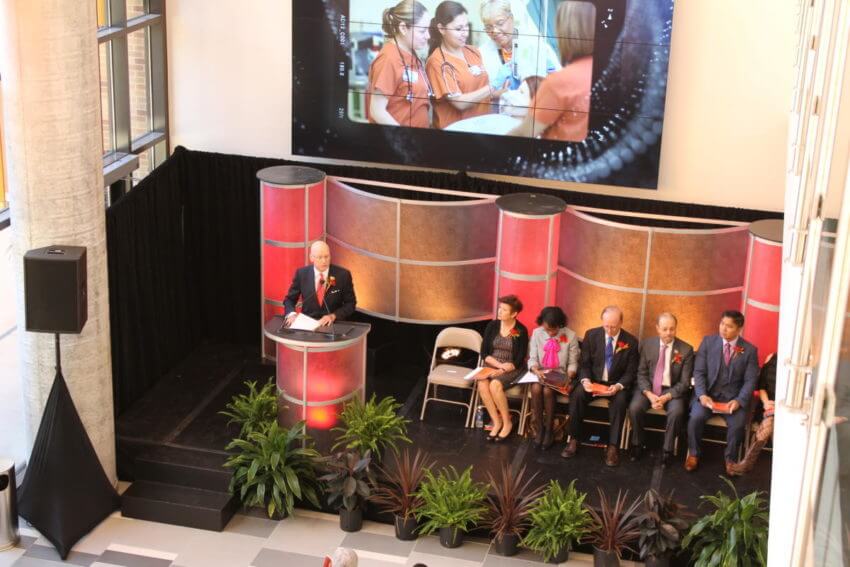Dr. William Henrich, president of the UT Health Science Center San Antonio, speaks at the ALTC dedication.
Building will foster active learning of tomorrow’s health care providers and scientists
The University of Texas Health Science Center at San Antonio on Feb. 16 dedicated the $51.2 million Academic Learning & Teaching Center (ALTC)—a technological marvel where classrooms enable real-time observation of procedures, complex surgeries and clinical simulations in a dynamic, discussion-based learning atmosphere.

Sara Martinez Tucker, member of The University of Texas System Board of Regents, accepted the building on behalf of the Regents and ceremonially turned it over to UT Health Science Center President William L. Henrich, M.D., MACP. The 130,000-square-foot ALTC features more than 33 ultra-modern classrooms and strategic learning spaces, and a state-of-the-art digital anatomy laboratory with 3-D interactive imaging capabilities. It also includes a restaurant, Panorama, to serve faculty, staff and students of the Health Science Center and their guests.
“As health educators, we have seen a massive explosion in knowledge,” Dr. Henrich said. “The Academic Learning & Teaching Center is one is of the nation’s most advanced learning environments, a worthy place to train the health care providers South Texas needs.”
ALTC classrooms range in size from a room the area of a football field that can accommodate 280 students to seminar rooms that seat 12-18. In every room, the technology and furniture design enhances questions and discussion—active learning at its best.
”Unique to this new teaching environment, there is no front or back of the classroom—it is an integrated space linked by technology,” said Francisco González-Scarano, M.D., dean of the School of Medicine and vice president for medical affairs. “The interaction this inculcates will enhance students’ ability to gain mastery of complex concepts of health care, both in the School of Medicine and throughout the Health Science Center.”
Teachers will access wireless technology, and students and groups will have connectivity to speak to the entire class when it is their turn to present a case study or other information. “Just as they do with mentors on grand rounds, clerkships and practicums, students will be able to ask their peers, ‘What are you seeing? Help me understand,’” Dr. González said.
San Antonio Mayor Ivy Taylor said the ALTC is the latest example of the vital role the Health Science Center plays in educating the next generation of health care providers for San Antonio and the region, and producing intellectual capital and graduates who bolster the local economy.
Bexar County Judge Nelson Wolff, who as judge helps oversee the county’s University Health System, noted that the ALTC’s addition will enhance the partnership of the Health Science Center and University Health System by preparing future doctors, nurses and other health care providers to heal the citizens of Bexar County and the region.
Regent Tucker said, “This structure is striking and will no doubt serve for decades to come as a beacon for outstanding teaching and learning for future health professionals.”
The digital anatomy laboratory in the sublevel of the ALTC contains 84 stations for student learning. The lab will reinforce the concepts and anatomical relationships that students are taught in the Health Science Center’s gross anatomy labs located elsewhere on campus, said Omid Rahimi, Ph.D., director of the human anatomy program and a Distinguished Teaching Professor in the Department of Cellular & Structural Biology in the School of Medicine.
The ALTC digital anatomy lab educational experience is equipped with a digital visualization system that allows:
—Faculty, fellows, residents and students to import a patient’s data (CT scans and MRI images of normal and diseased anatomy) and view it in 3-D.
—Manipulation of the anatomical images using a video controller; students can rotate images, zoom in and out, filter for certain tissues, and generate virtual cross-sections in any plane.
—Projection of images onto screens in the lab, where students can view the images in 3-D using goggles that add depth to what they are seeing.
“This visualization system enhances the educational experience beyond what we can do in the gross anatomy lab,” Dr. Rahimi said. “You can’t pick up a set of blood vessels in isolation of other tissues and rotate them in front of your face. This tool allows students to do that. We are certainly excited about it.”
The digital anatomy lab will not replace traditional gross anatomy instruction, but it will complement students’ understanding of the structure and function of organs, bones, muscles, nerves and tissues they are studying, Dr. Rahimi said.
The UT System Board of Regents approved $45 million from the Permanent University Fund to construct the ALTC. Kell Munoz Architects designed the building and Bartlett Cocke General Contractors supervised the construction.
For current news from the UT Health Science Center San Antonio, please visit our online newsroom, like us on Facebook, follow us on Twitter or view us on YouTube.
The University of Texas Health Science Center at San Antonio, with missions of teaching, research and healing, is one of the country’s leading health sciences universities. Its schools of medicine, nursing, dentistry, health professions and graduate biomedical sciences have more than 32,200 alumni who are advancing their fields throughout the world. With six campuses in San Antonio and Laredo, the university has a FY 16 revenue operating budget of $801.8 million and is the primary driver of its community’s $30.6 billion biomedical and health care industry. For more information on the many ways “We make lives better®,” visit www.uthscsa.edu.


